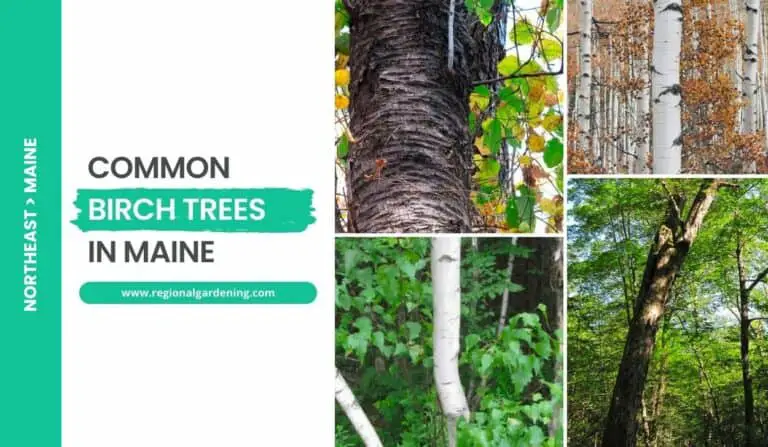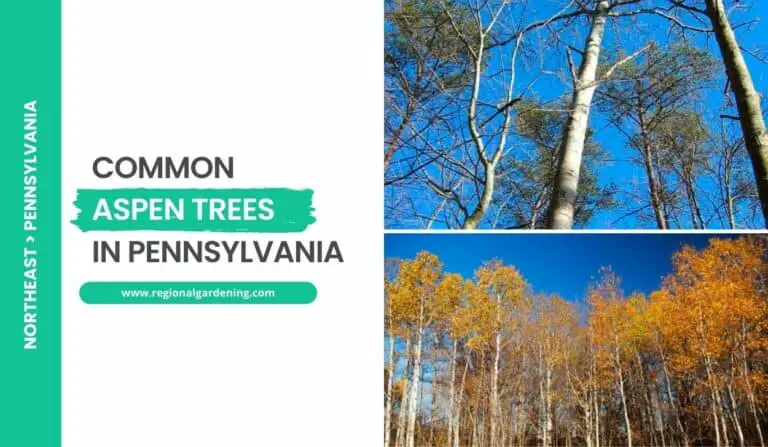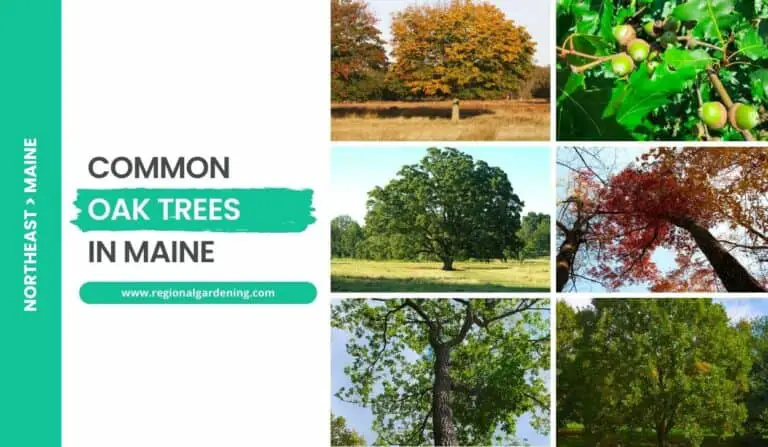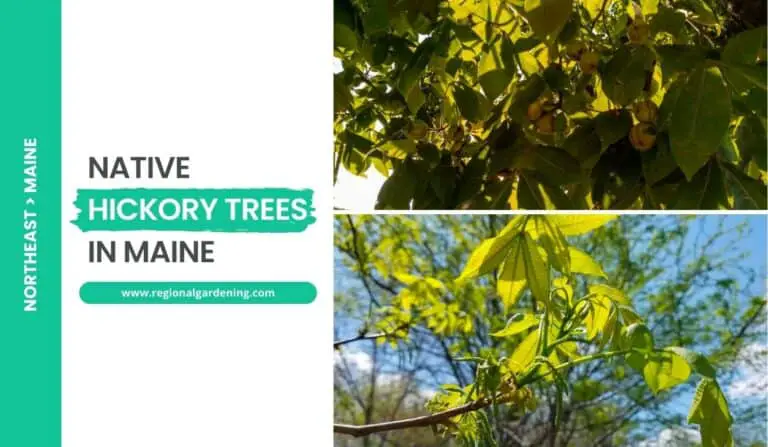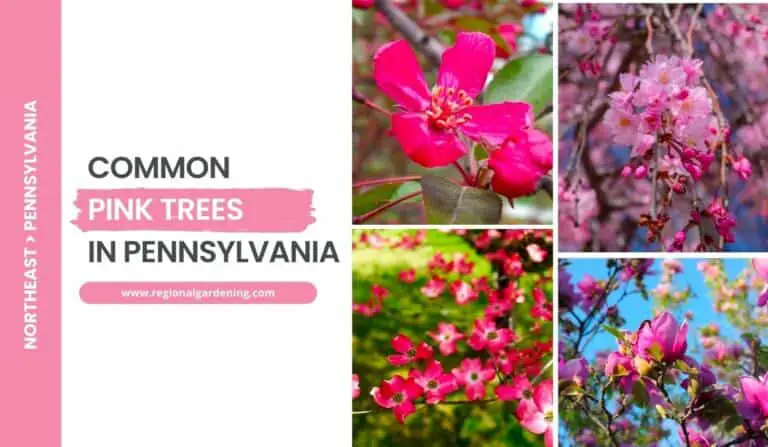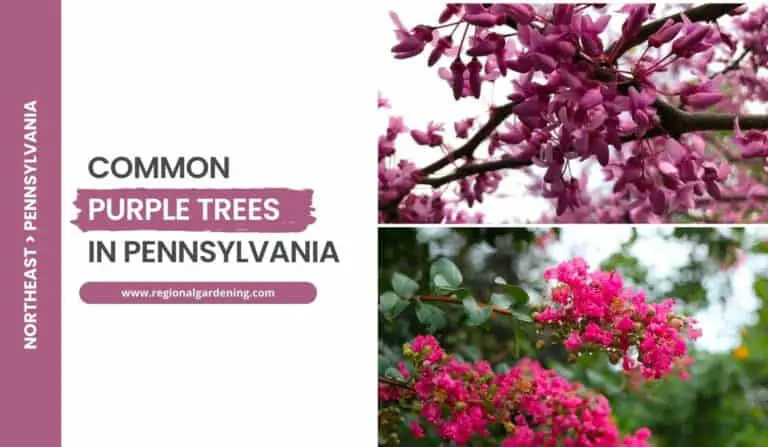6 Palm Trees In Pennsylvania (Photos & Identification)
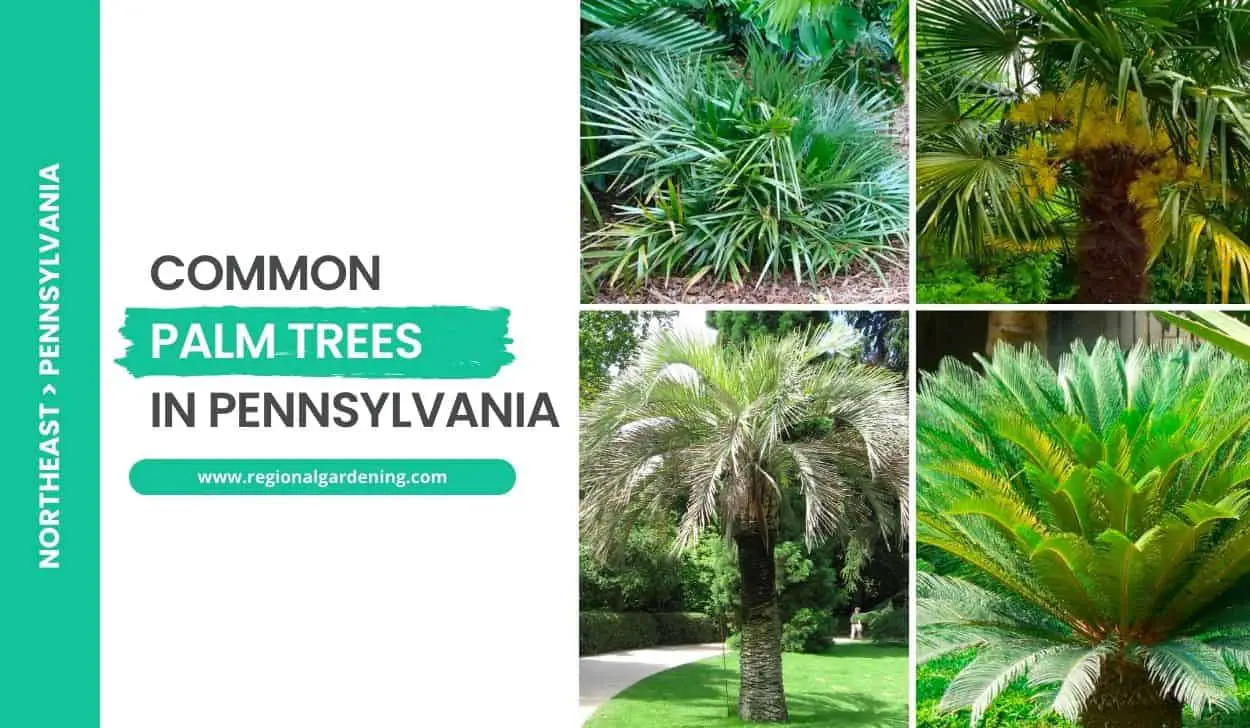
While palm trees are typically associated with warm, tropical climates, you might be surprised to learn that there are six varieties that, with proper care, can thrive in Pennsylvania’s climate.
We will look at these hardy palm trees in this article, complete with high-quality photos and detailed descriptions to help you identify and grow them. From the ever-popular Windmill Palm with its fan-shaped leaves to the elegant Needle Palm with its needle-like foliage, we will discuss the distinct beauty and resilience of each palm tree species.
So, let’s start exploring the six palm trees in Pennsylvania one by one.
1. Needle Palm
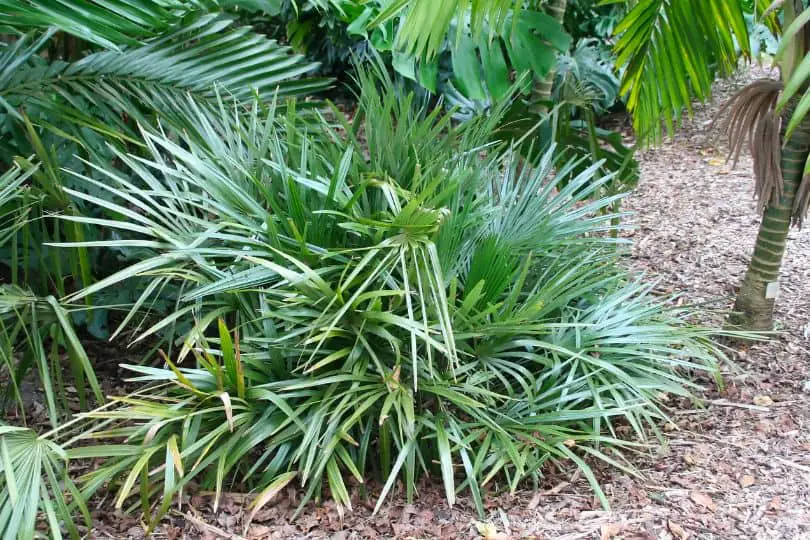
- Scientific Name: Rhapidophyllum hystrix
- Common Name(s): Needle Palm, Porcupine Palm
- Mature Height: 6-10 feet (1.8-3 meters)
- Native Region: Southeastern United States
- Flowers: Small, yellowish flowers on large branched clusters
- Fruit: Dark brown to purple-black, spherical fruit
- Uses: Ornamental tree in gardens and landscapes, provides tropical aesthetic, can be grown in containers indoors
The Needle Palm, commonly known as Rhapidophyllum hystrix, is a tiny Arecaceae family evergreen palm. Because of its ability to withstand frigid weather, it is widely seen in Pennsylvania landscapes and gardens. The Needle Palm can grow to be 6-10 feet tall, making it ideal for modest locations.
This palm tree is endemic to the southeastern United States and thrives in Pennsylvania’s climate. It gets its name from its distinctive, fan-shaped leaves with sharp, needle-like spines along the stems. The lush green foliage has a tropical appearance and adds a touch of exoticism to the Pennsylvania environment.
The Needle Palm is often found in sandy or rocky settings, often in floodplain forests, in the wild. It may grow in a variety of soil conditions, but favors well-drained soil. The Needle Palm is commonly utilized as an ornamental tree in gardens and landscaping in Pennsylvania. Once established, it is a low-maintenance plant that requires little attention.
The Needle Palm produces little yellowish flowers on enormous branched clusters in the spring. These flowers are followed by spherical dark brown to purple-black fruits. The fruits add a visually appealing feature to the tree.
Locals in Pennsylvania value the Needle Palm for its resilience and distinctive beauty. It is frequently used in gardens, porches, and patios to create a tropical ambiance. It can also be cultivated in containers and taken inside during the colder months. Its spiky spines along the leaves make it an effective barrier plant, adding to its allure for solitude. The Needle Palm has become a popular addition to Pennsylvania landscapes due to its capacity to resist frigid temperatures.
2. European Fan Palm
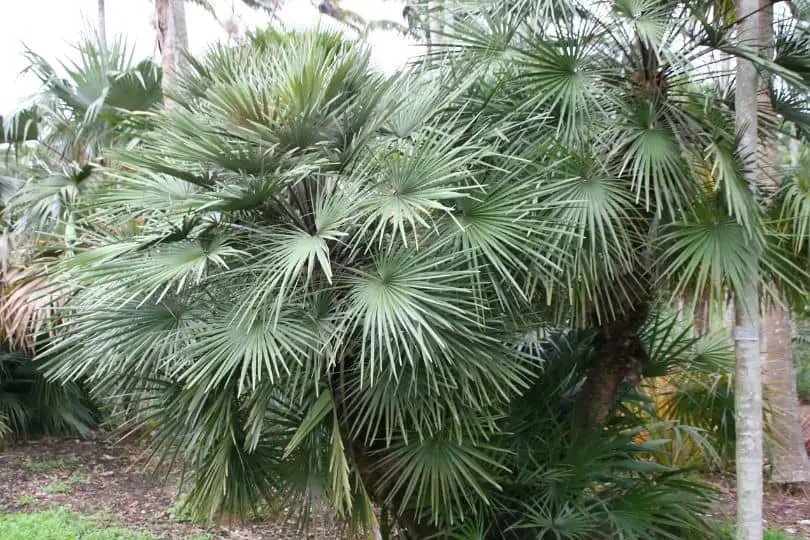
- Scientific Name: Chamaerops humilis
- Common Name(s): European Fan Palm, Mediterranean Fan Palm
- Mature Height: 6-10 feet (2-3 meters)
- Native Region: Mediterranean region, specifically Europe and North Africa.
- Flowers: Yellow flowers in clusters, followed by small black fruits.
- Uses: Often used as an ornamental tree in landscapes and gardens. The leaves are also used for weaving and thatching.
The European Fan Palm, also known as the Mediterranean Fan Palm, is a tiny palm tree that grows to be 6-10 feet (2-3 meters) tall when mature. It grows in clumps, with several trunks sprouting from the base and covered in fibrous brown bark. The European Fan Palm has palmate, fan-shaped leaves with stiff segments that are sharply split into pointed lobes. The leaves are a vivid green color and can grow to be 24 inches (60 cm) long or more.
The European Fan Palm, which is native to the Mediterranean region, thrives in Mediterranean climates, including parts of Pennsylvania. It grows best in full sun to partial shade and tolerates a variety of soil types as long as they are well-drained. Because the European Fan Palm is not as cold-hardy as other palm trees, it should be planted in a sheltered place in Pennsylvania. It is essential that you protect yourself from fierce winter winds and chilly temperatures.
The European Fan Palm blooms in late spring or early summer with clusters of little yellow flowers. These flowers are followed by little black fruits the size of cherries. While not generally grown for fruit production, the European Fan Palm’s stunning blossoms and fruits give a unique visual interest to landscapes and gardens.
In Pennsylvania, the European Fan Palm is extensively utilized as an ornamental tree. Because of its tiny size and lovely leaf, it is ideal for small gardens, patios, and containers. It can also be utilized as a focal point or accent plant in the landscape, bringing a touch of elegance and a tropical vibe. Furthermore, the European Fan Palm leaves are utilized in traditional crafts such as weaving and thatching.
It is critical to provide well-draining soil and shield the European Fan Palm from harsh winter conditions when caring for it in Pennsylvania. Mulching around the tree’s base can assist insulate the roots during the winter months. Watering is required on a regular basis, especially during the hot and dry summer months. Pruning can be used to remove dead or damaged fronds, but avoid removing too many healthy fronds, as this is harmful to the tree’s health.
3. Pindo Palm
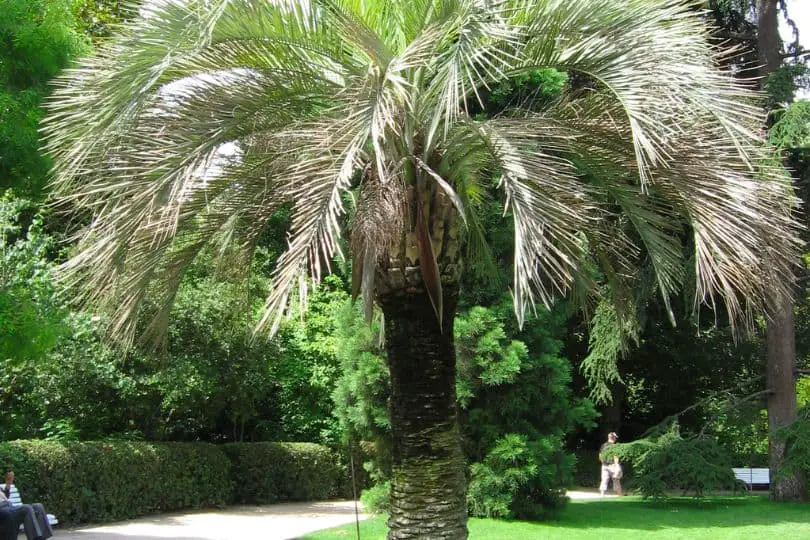
- Scientific Name: Butia capitata
- Common Name(s): Pindo Palm
- Mature Height: 10-20 feet (3-6 meters)
- Native Region: South America
- Flowers: Small yellow to orange flowers in clusters
- Fruit: Small yellow to orange edible fruits
- Uses: Ornamental tree in landscapes, fruits can be used to make jelly or wine.
The Pindo Palm, commonly known as Butia capitata, is a small to medium-sized South American palm tree. It is widely seen as an ornamental tree in Pennsylvania landscapes. The Pindo Palm mature height ranges from 10 to 20 feet (3 to 6 meters), making it an ideal choice for smaller gardens or as a focal point in bigger landscapes.
The Pindo Palm has bluish-green fronds that are long and arching. The fronds are pinnate, which means that the leaflets are feather-like and linked to a central stem. The Pindo Palm’s trunk is quite narrow and covered in a tough, fibrous bark. This palm tree is noted for its toughness and capacity to resist lower weather, making it ideal for the environment of Pennsylvania.
When it comes to blooms, the Pindo Palm has little yellow to orange flowers that grow in bunches. The flowers enhance the scenery while also providing food for pollinators such as bees. The tree bears little yellow to orange edible fruits after blossoming. These fruits are popular among locals and are frequently used to produce jelly or wine.
To care for the Pindo Palm in a Pennsylvania landscape, plant it in well-drained soil and water it regularly. This palm tree can grow in a variety of soil conditions, but it favors slightly acidic soil. It is also critical to shield the tree from high gusts, particularly during the winter months. The Pindo Palm is low-maintenance and does not require trimming on a regular basis.
The Pindo Palm is largely utilized as an ornamental tree in Pennsylvania, bringing a tropical touch to gardens. It is a popular choice among homeowners due to its gorgeous fronds, vivid flowers, and edible fruits. The Pindo Palm also provides shade and might help to create a more tropical environment in the yard. So, whether you want to add a tropical flair to your landscape or enjoy the delicious fruits it provides, the Pindo Palm is an excellent choice for Pennsylvania gardens.
4. Sago Palm
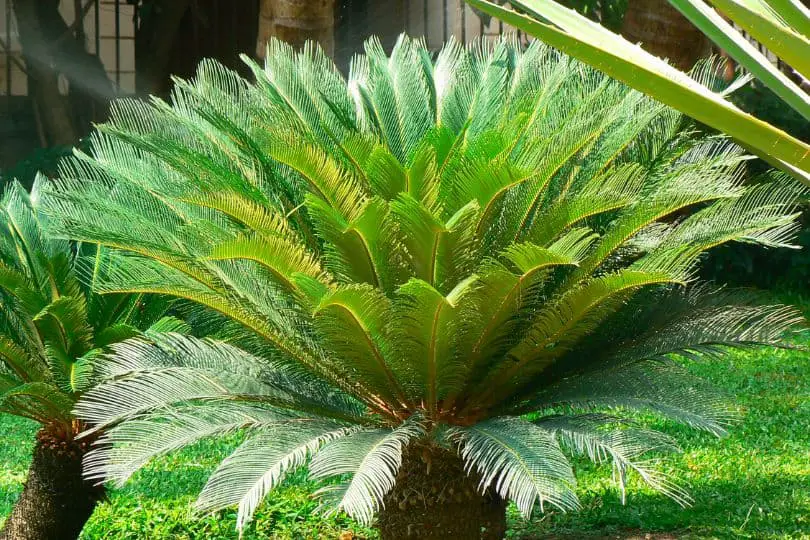
- Scientific Name: Cycas revoluta
- Common Name(s): Sago Palm, King Sago Palm
- Mature Height: 6-10 feet (1.8-3 meters)
- Native Region: Japan
- Flowers: No flowers.
- Fruit: Orange to red cones.
- Uses: Ornamental plant, used in landscaping.
In Pennsylvania, the Sago Palm, also known as Cycas revoluta or King Sago Palm, is a popular decorative plant. This palm tree is not a genuine palm, yet it is frequently misidentified as one. It is indigenous to Japan and matures to a height of 6-10 feet (1.8-3 meters).
The feathery, dark green leaves of the Sago Palm extend from a central point, creating a symmetrical rosette pattern, giving it a distinct and appealing appearance. The glossy, leathery leaves add a tropical touch to any landscape. The trunk of the Sago Palm is thick and coated in dark, hairy bark.
The Sago Palm is often planted as a container plant in Pennsylvania and taken indoors during the winter months. It demands bright, indirect light and prefers a well-draining soil mix. It should be placed in a covered area when grown outdoors to protect it from high winds and low weather.
The Sago Palm is a slow-growing plant that requires little attention. It is drought-resilient and may thrive in low-water environments. During dry periods, however, regular watering will assist in maintaining its health and attractiveness. In the spring and summer, fertilizing the plant with a balanced palm fertilizer can encourage growth and greenery.
While the Sago Palm does not have beautiful blossoms, as it matures, it has orange to crimson cones. These cones are not edible and can be hazardous if consumed, so use caution around children and pets. The Sago Palm is generally utilized as an aesthetic plant, adding a tropical flavor to gardens, patios, and indoor spaces.
Because of its unusual appearance, low maintenance requirements, and ability to survive in containers, the Sago Palm is a popular choice for landscaping in Pennsylvania. It adds beauty and exoticism to any outdoor scene. Locals value the Sago Palm for its year-round foliage and ability to endure the region’s colder weather.
The Sago Palm is a flexible and beautiful addition to Pennsylvania landscapes, whether planted as a focal point in a garden or as a potted plant on a patio. Its rough appearance and lovely leaves make it a favorite of gardeners and plant enthusiasts alike.
5. Saw Palmetto
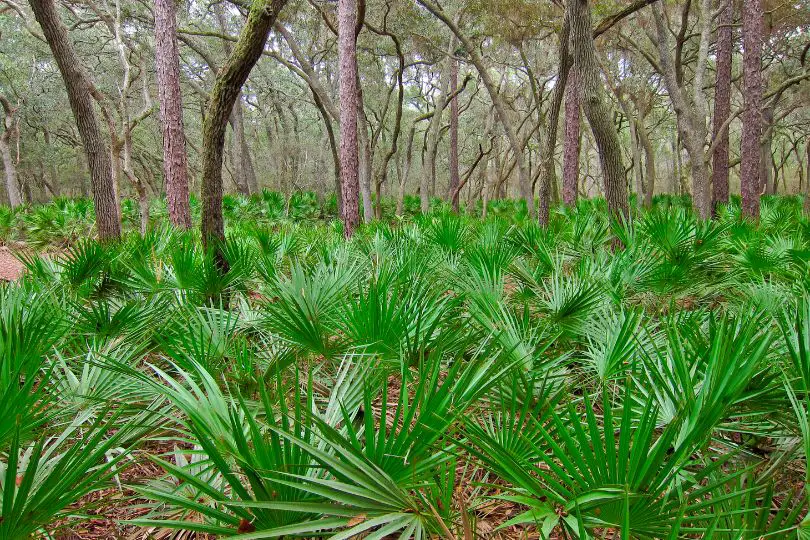
- Scientific Name: Serenoa repens
- Common Name(s): Saw Palmetto
- Mature Height: 6-10 feet (1.8-3 meters)
- Native Region: Southeastern United States, including Florida
- Flowers: Cream-colored flowers in clusters
- Fruit: Dark purple-black berries
- Uses: Saw Palmetto is commonly used as a natural remedy for prostate health and to promote hair growth. The berries are also edible and can be used to make jams and jellies.
Serenoa repens, or saw palmetto, is a tiny palm tree native to the southeastern United States, mainly Florida. It grows to a mature height of 6-10 feet (1.8-3 meters). The plant has a cluster of fan-shaped leaves that can reach a length of 3-4 feet. The leaves are green and have sharp, saw-like teeth along the margins, giving rise to the common name “Saw Palmetto.”
Saw Palmetto bark has a rough, fibrous feel and is usually dark or gray in color. The tree bears little cream-colored flowers that grow in groups. These flowers appear in late spring or early summer. The Saw Palmetto fruit is a dark purple-black berry that ripens in the fall. The berries have medicinal characteristics and are frequently used in natural therapies for prostate health and hair development.
Saw Palmetto is an excellent choice for Pennsylvania landscapes since it tolerates a broad range of soil conditions, including sandy and acidic soils. It grows well in full sun to light shade. This palm tree is also recognized for its drought resistance, which makes it more adaptable during droughts. However, regular watering is required during the establishing stage. Saw Palmetto requires little care and is low-maintenance once planted.
Saw Palmetto is mostly employed for decorative reasons in Pennsylvania. It lends a tropical flavor to landscapes and can be planted alone or in groups. Saw Palmetto berries are also delicious and have traditionally been used to make jams, jellies, and other culinary preparations. It is also a popular alternative for natural healthcare, particularly for treating prostate problems and increasing hair growth.
6. Windmill Palm Tree
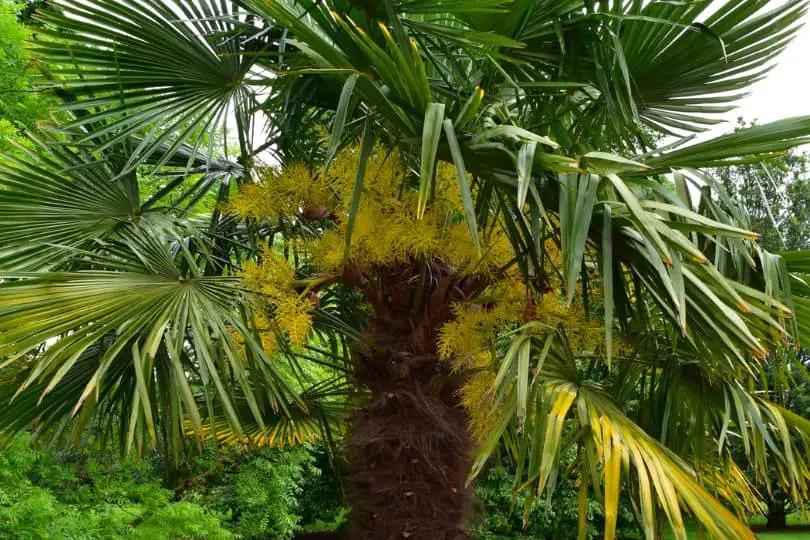
- Scientific Name: Trachycarpus fortunei
- Common Name(s): Windmill Palm Tree
- Mature Height: 20-40 feet (6-12 meters)
- Native Region: Southeast Asia
- Flowers: Small, yellow flowers in large clusters
- Fruit: Small, blue-black berries
- Uses: Ornamental tree, commonly found in landscapes, parks, and gardens.
The Windmill Palm species (Trachycarpus fortunei) is a prominent palm species that can be seen in Pennsylvania landscapes. It is native to Southeast Asia and is recognized for its unusual appearance as well as its cold resistance. This palm tree can expand to a height of 20-40 feet (6-12 meters), making it an ideal choice for adding a tropical feel to the landscape.
The Windmill Palm Tree has a distinctive trunk covered in brown fibers that looks like wrapped burlap. Its leaves are big and fan-shaped, with many segments that give them a feathery look. The tree’s crown is compact, giving it the appearance of a windmill, thus the common name.
The Windmill Palm Tree is commonly grown as an attractive tree in landscaping, parks, and gardens in Pennsylvania. It is suitable for this region due to its cold tolerance, as it can endure freezing temperatures and snow. It enjoys well-drained soil and needs to be watered on a regular basis, especially during dry months. It also works nicely in both full sun and light shade.
The Windmill Palm Tree blooms in enormous clusters of tiny yellow flowers in the spring. These blossoms beautify the tree and attract pollinators like bees and butterflies. The tree produces small, blue-black berries in the summer, which birds like.
The Windmill Palm Tree is popular among Pennsylvania residents for its decorative appeal. Its tropical aspect provides a one-of-a-kind flair to any scene, giving it an exotic feel. Because of its cold endurance, it is a popular choice for individuals who want to include a palm tree in their Pennsylvania garden without fear of winter damage.
Similar Articles
- Common Flowering Trees In Pennsylvania
- Common Maple Trees In Pennsylvania
- Common Cherry Trees In Pennsylvania
- Common Pine Trees In Pennsylvania
- Native Locust Trees In Pennsylvania
- Common Nut Trees In Pennsylvania
- Common Cedar Trees In Pennsylvania
- Common Oak Trees In Pennsylvania
- Common Birch Trees In Pennsylvania
- Common Aspen Trees In Pennsylvania
- Common Spruce Trees In Pennsylvania
- Common Ash Trees In Pennsylvania
- Common Elm Trees In Pennsylvania
- Pink Flowering Trees In Pennsylvania
- White Flowering Trees In Pennsylvania
- Purple Flowering Trees In Pennsylvania
Palm Trees In Pennsylvania – Sources
The Regional Gardening team makes sure that the information in our articles is accurate by only using sources that are known to be trustworthy. Some of these sources are peer-reviewed journals from government agencies, well-known universities, and scientific research organizations.
- Native Plant Resources, Pennsylvania Native Plant Society
- Trees & Shrubs Varieties, PennState Extension
- Landscaping With Natives, Pennsylvania Department Of Conservation, & Natural Resources.
- Explore Pennsylvania Forests, Pennsylvania Department Of Conservation, & Natural Resources.


